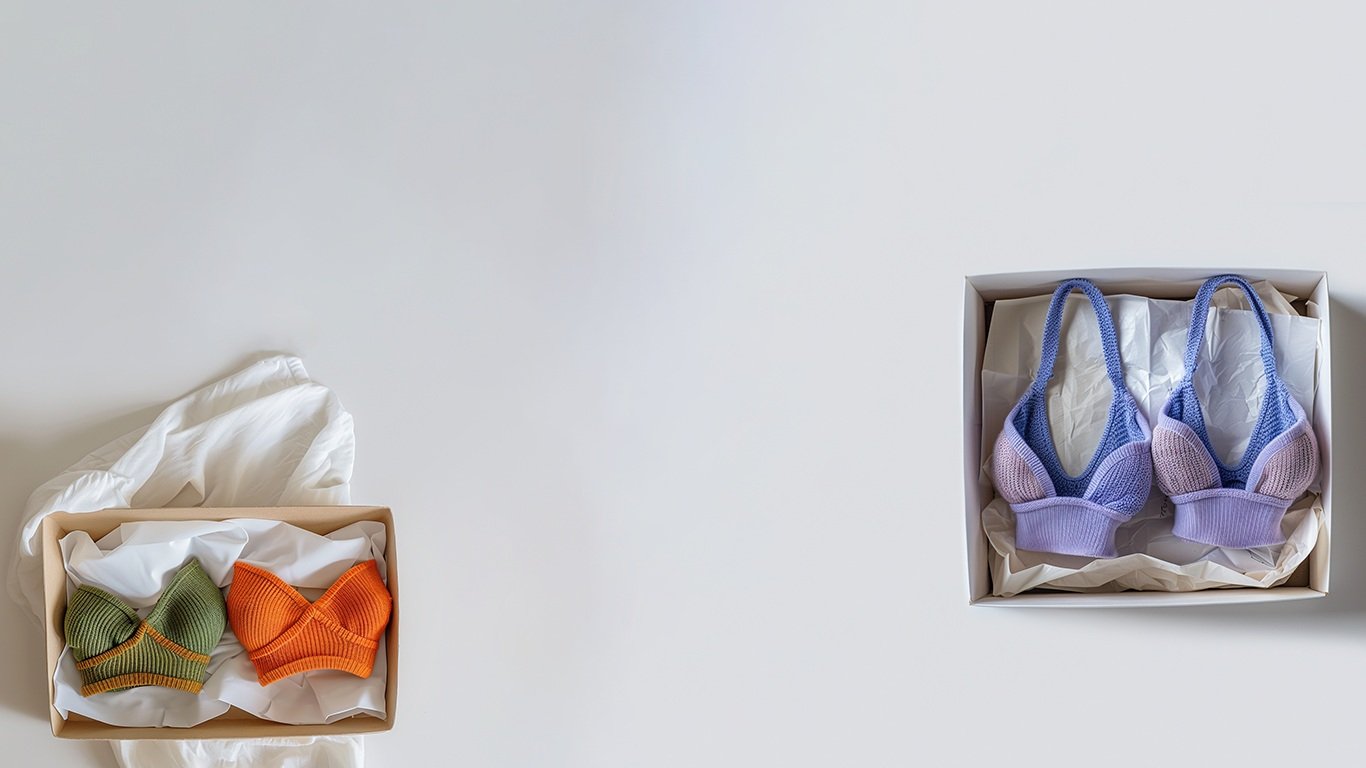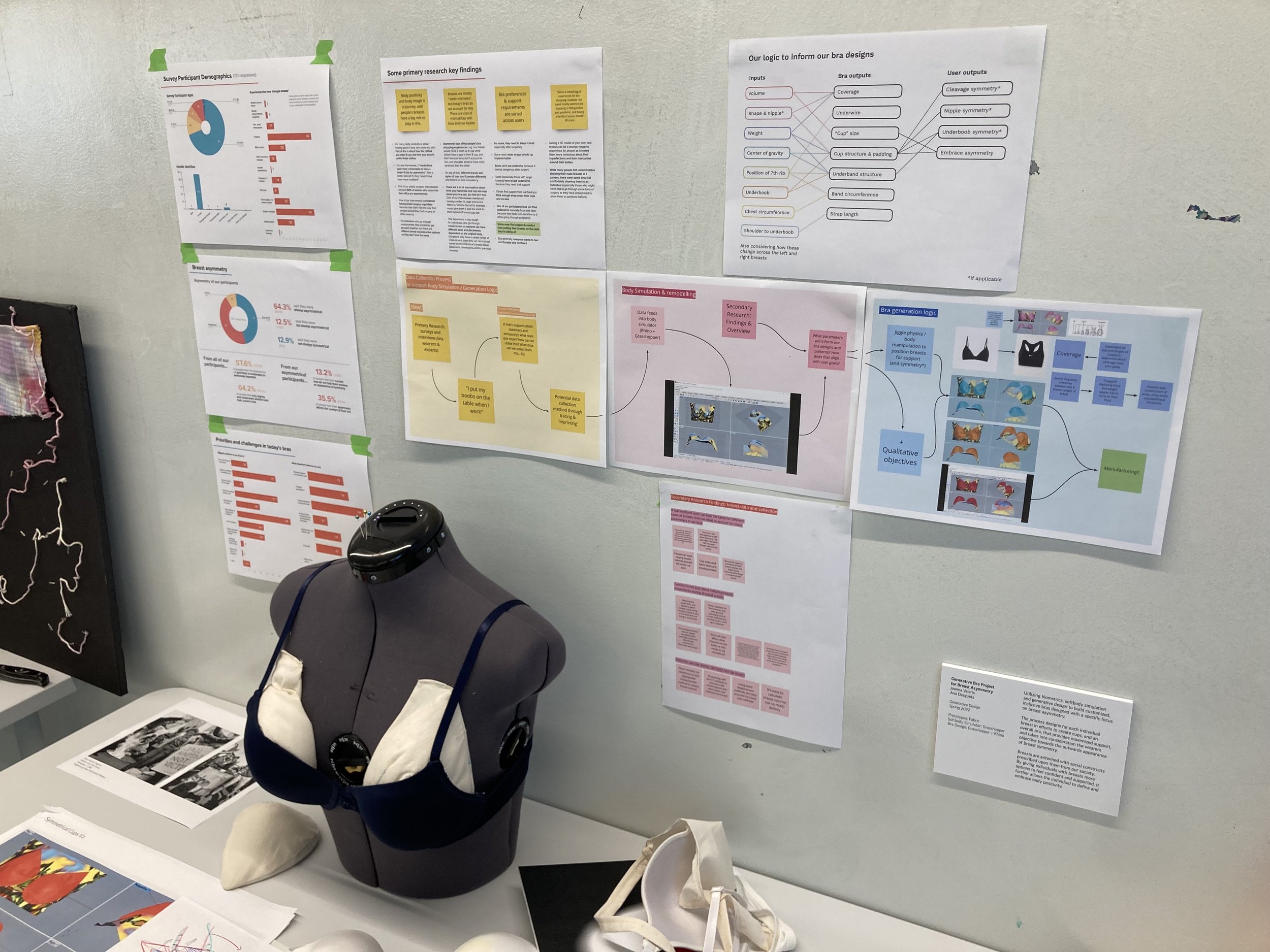Generative Custom Bras
Leveraging technology to design inclusive shopping experiences
Role: Co-researcher, service designer
Focus: Generative technologies, interaction design, service design
Time: Mar - Oct 2022 (7 months)
Bra concept prototypes
Generative technologies have made data-driven, individualized outcomes more scaleable than ever before. So how could we apply generative tech to create more inclusive experiences for a more diverse range of people? This project explores how this can be done through support garments for bra wearers: can we finally have garments that fit our bodies, rather than the other way around?
Context
Generative design takes massive amounts of individualized data and creates personalized outcomes.
So far, generative technology has been largely applied to the arts, and increasingly through large language models. However, when we feed it with individualized data, we can generate customization in a way that is scaleable and profitable, allowing businesses to create more diverse outcomes for customers without additional costs. As a result, generative technologies is increasingly being explored in the wearables space.
New Balance x Nervous System generated shoe midsoles from individual runners’ feet pressure data to customize shoe support and optimize performance.
The challenge
Miro workspace
Bras were created in the 1800s, but finding the right fitting bra is still difficult and confusing.
This is largely due to bras being an inherently standardized garment for a bodies that are not standardized. For example:
People have different preferences and priorities for their bras (e.g: style, padding, cut). There’s no one bra fits all.
Bras assume that human bodies are symmetrical, but we are not. What works for one side might not for the other.
Human needs also fluctuate with age, menstrual cycles, medical/surgical needs, weight gains, people who are transitioning, nursing mothers etc.
Until now, mass manufacturing has been the only viable way to make enough bras for the population that needs it, but it can’t accommodate for individual needs. There have been many efforts to do so but they are still not perfect (e.g: quizzes to redirect you to standardized bras, micro-sizes that are still symmetrical, expensive bespoke bras, specialized but unflattering bras etc). So what are people missing in their current bras? How can generative technology support and scale individual needs that are still left unmet?
The approach
Surveying 100+ bra wearers
12 in-depth interviews with a range of bra wearers
5 expert interviews
Exploring what’s possible (generative technology explorations, what have past researchers done?)
Prototyping service concepts and data collection methods
“It’s really frustrating, because it’s hard to get a bra that fits... it feels like either one is working and then the other one is not. ”
Driving insights
People’s needs out of a technology-based bra service are diverse: everyone has different definitions of what bras feel supportive and ‘fits well’ means for them. There are also different levels of comfort with the required data privacy and data collection methods for a generative service.
A single service model and experience cannot account for all of these needs.
For priorities of a new bra and bra service:
100% of interviewees ranked accuracy in their top 3, while only 11% ranked cost.
Not only did this validate the need for better bras, but it also emphasized how important it is for bra wearers to find products that match their specific needs.
Overall, bra fit can make a significant difference to the wearer’s self confidence.
“I considered [a] reduction of my right breast because with some outfits, I wish they looked symmetric. And then I avoid wearing certain things because of that.”
— Interviewee
Understanding and learning how to find a well fitting bra is challenging. There’s a tension between passing down knowledge through trusted sources like family and friends (though that knowledge can sometimes be misinformed), and learning via “awkward”, “uncomfortable” impersonal sources like in-store fittings, doctors, or media representation. Generative technologies and personalized data could have the power to disseminate more informed bra education, but when handling personal data for a new bra service,
Building trust is essential.
People need a service that creates bras that finally fit them, and that they can feel confident in.

The concept
TrueFit Bras is a data-driven, digital service that crafts 3D knit bras and embraces your natural body.
TrueFit Bras focus on precision and personalization to create the best fit.
Generative modeling of the body to build custom garments on
Precision
Using data capture methods, informed by medical experts, that give us enough precision to capture the unique needs of the body.
Personalized digital shopping experience for the bra shopper
Personalization
Our digital app & platform allows people to share their info, bra priorities and goals. The user can then inform TrueFit’s algorithm and collaboratively create the perfect bra. Using this platform, they are also able to get bra and breast education, and find validation in other TrueFit shoppers who might have similar experiences as them.
Our starting efforts are aimed at creating bras for asymmetrical bodies.
But we believe that TrueFit bras can expand to include bodies that are going through transitions too (e.g: mastectomies, breastfeeding, gender transitions etc)!
Modular service map for TrueFit’s concept
TrueFit’s service concept is built on modularity so that it can be adapted for different preferences and priorities.
While this is the starting point for TrueFit’s service delivery, we want alternate variations to be made for people with different preferences with respect to privacy and data security.



















